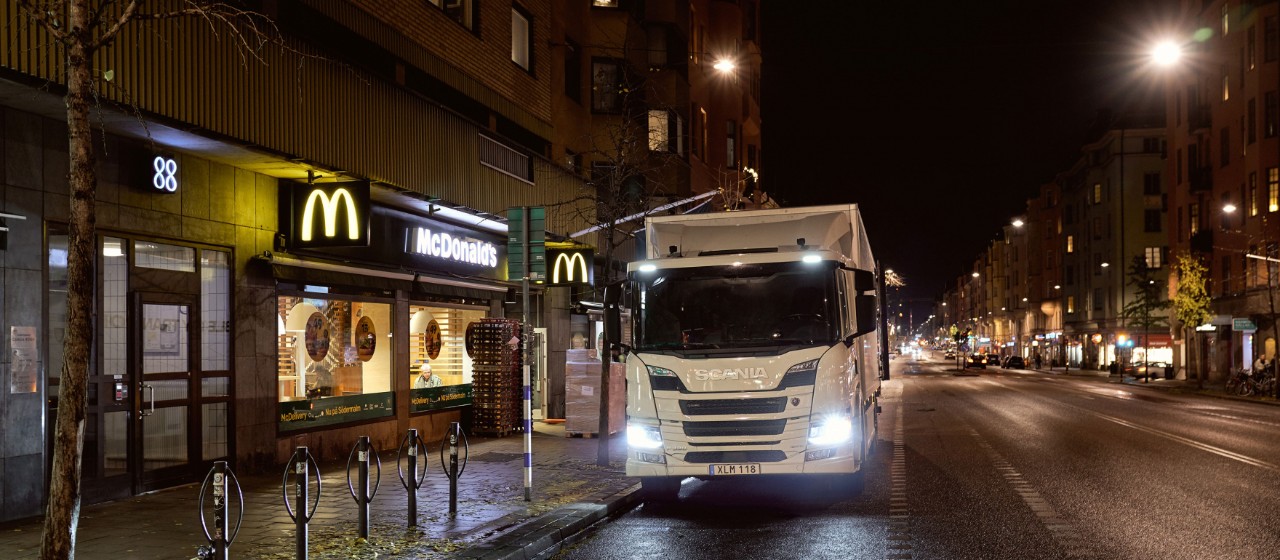
Night-time deliveries save time and slash emissions
12 DECEMBER 2019
Night-time deliveries in Stockholm made possible through driving in a silent electric mode significantly reduce delivery times, resulting in lower emissions of carbon dioxide, nitrogen oxide and particulate matter.
The City of Stockholm has a general ban on all heavy truck traffic between 10pm and 6am, to help its residents get a good night’s sleep. In a project, which is partly financed by EU, the city of Stockholm has, together with supply chain partner HAVI, McDonald’s, Scania and the Royal Institute of Technology set out to demonstrate the effects from zero emission night time deliveries in Stockholm.
The city granted special permission to test the effects of night-time or “off-peak” deliveries. The deliveries to six McDonald’s restaurants in the city centre were carried out by HAVI, using Scania’s hybrid plug-in vehicle.
From January until the end of August 2019, HAVI drove three weekly delivery routes from its warehouse, which lies 22 kilometres from inner-city Stockholm. En route from the warehouse, the truck was driven on the biofuel Hydrotreated Vegetable Oil (HVO). When it entered the city, the truck’s geofencing system automatically prompted it to switch to electric mode. It was also possible for the truck to charge its batteries while making deliveries to one of the restaurants.
The operations over this eight-month period have now been evaluated by Lots Group, which compared the plug-in hybrid truck’s performance with corresponding deliveries by four Scania Euro 5 and Euro 6 delivery trucks.
The evaluation shows that, on average, off-peak deliveries were 30 percent quicker than the average for the equivalent daytime transport route. And these night-time deliveries were an average 38 percent quicker than daytime deliveries made during the narrower timespan of 7am to 12 noon.
Off-peak deliveries with hybrid and non-hybrid trucks generally contribute to lower emissions due to an easier parking process at delivery points, less queuing, higher speeds and more frequent incidences of green lights at intersections.
The Euro 5 and Euro 6 reference trucks were all fuelled by renewable HVO, which already reduces carbon emissions by 90 percent compared with conventional fossil diesel. Yet the carbon emissions for off-peak deliveries with the Scania hybrid truck were on average 44 percent lower still than the reference vehicles, primarily because of the electric motor.
The mitigating effects on other emissions are equally encouraging. The results show that night-time, off-peak deliveries in the plug-in hybrid reduced particulate matter (PM10) emissions by 28 percent and slashed nitrogen oxide emissions by more than 80 percent.
These large reductions are mainly due to there being less time spent driving and queuing during the night and the better availability of parking, but they are also partly due to the inclusion of a Euro 5 truck as reference vehicle.
As part of the evaluation, the HAVI test driver who drove the plug-in hybrid was asked to comment on the benefits of night-time deliveries.
“It’s much easier to drive due to there being less traffic, simpler manoeuvring and fewer other vehicles to consider,” he said. “There is also more space to park, and the restaurant staff welcome deliveries at night since there are fewer customers, which gives them time to receive goods, without stress.”
The evaluation is clear about the advantages of night-time distribution.
“This shows the potential for remarkable transport efficiencies and the societal benefits of utilising off-peak deliveries.”